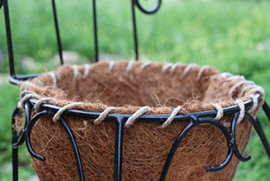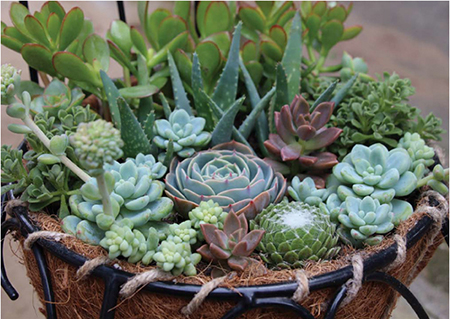
SUCCULENT CHAIR
A chair planter is a great way to add character to your garden. This DIY came about because we found these cute metal chairs, but no pots or baskets would fit into the seat opening. So, of course, when you can’t buy, you’ve gotta DIY! Metal chair pot-holders like this one are available at some garden centers and online.
WHAT YOU NEED
- Metal Chair
- Coconut Fiber Planter Liner
- Screwdriver
- Jute Twine
- Transparent Tape
- Scissors
- Soil
- Succulents
WHAT TO DO
- Start by fitting your coconut fiber planter liner into the seat hole of your chair. If your liner is too big, simply fold it so that it overlaps and fits into the opening.

- Take your liner out and use a screwdriver to create holes along the upper edge. Be sure not to place your holes too close to the edge.

- Tie one end of your jute twine to the rim of the chair and wrap the other end with tape to keep it from fraying. You will be using the twine to “sew” your liner to the chair, so make sure you give yourself plenty of length to work with.

- Begin sewing your liner to the rim of your chair. You may need to use your screwdriver to reopen the holes along the way if the twine doesn’t easily fit into the holes.

- Once you have made it all the way around the circle, tie your twine and cut off any remaining length.

- Lightly fill your awesome new chair planter with soil. Don’t pack it in tightly, as you don’t want to stretch out the liner.
- Plant your succulents! Start by adding your tallest plants in the back and work your way forward. Choose two or three plants to be your attention-grabbers, or focal points. They can be brightly colored or slightly bigger than the other plants to set them apart. Fill in any empty space with smaller plants so that you don’t have a lot of soil showing.

CARE INSTRUCTIONS
Place your succulent-filled chair where it will receive plenty of bright, indirect sunlight. Water when the soil is dry.
TIP!
Over time, the coconut fiber liner may thin because of the weight of the soil and plants. It’s a good idea to reinforce your liner. You can do this by looping your twine all the way under the liner, creating a support system. If you don’t like the look of the twine against the coconut fiber, try using clear fishing wire.







